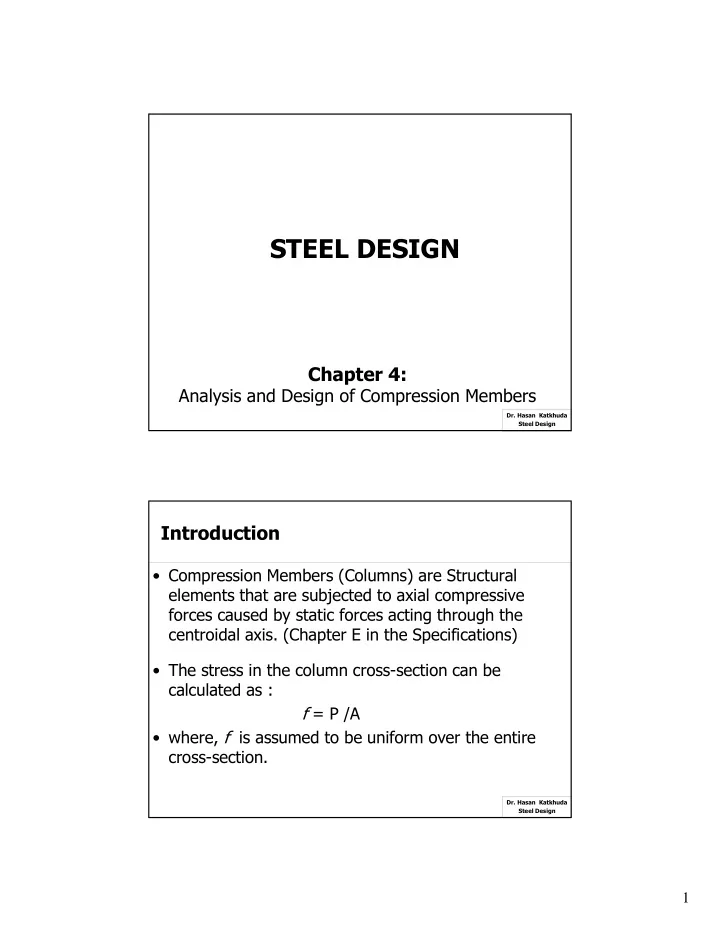

������������� ������������ Analysis and Design of Compression Members ��������������������� ������������� ������������� • Compression Members (Columns) are Structural elements that are subjected to axial compressive forces caused by static forces acting through the centroidal axis. (Chapter E in the Specifications) • The stress in the column cross#section can be calculated as : f = P /A • where, f is assumed to be uniform over the entire cross#section. ��������������������� ������������� 1
������������� • Mode of failure for compression members: 1.Flexural (Euler) Buckling: • Members are subjected to flexure or bending when they become unstable. ��������������������� ������������� ������������� 2. Local Buckling: • This type of buckling occurs when some parts of the cross#section of a column are so thin that they buckle locally in compression before the other modes of buckling can occur. ��������������������� ������������� 2
������������� 3. Flexure torsional Buckling: • These columns fail by twisting or by combination of torsional and flexural buckling. • Types of sections: ��������������������� ������������� ���� �������!�"������#�� ���$� ��������������������� ������������� 3
���� �������!�"������#�� ���$� M = P cr y • Second order, linear, homogeneous differential equation with constant coefficients. y’’ + c 2 y = 0 ��������������������� ������������� ���� �������!�"������#�� ���$� B = 0 (trivial solution) , P = 0 ��������������������� ������������� 4
���� �������!�"������#�� ���$� ��������������������� ������������� ���� �������!�"������#�� ���$� • ��������������������� ������������� 5
�%� ���� • A W12 X 50 column is used to support an axial compressive load of 145 kips. The length is 20 feet, and the ends are pinned. Investigate the stability of the column. ��������������������� ������������� ����&��������������''����(���������� • Effective length (KL): is the distance between points of inflection (zero moments) in the buckled shape. • Ex.: k = 0.7 (Fixed – pinned) ��������������������� ������������� 6
����&��������������''����(���������� ��������������������� ������������� ����&��������������''����(���������� ��������������������� ������������� 7
����&��������������''����(���������� ��������������������� ������������� ���� ���#�� ����� • The testing of columns with various slenderness ratios results in scattered range of values. ��������������������� ������������� 8
���� ���#�� ����� • ���� ���!����� 1. Short columns: • No Buckling. • Failure stress equal to yield stress. 2. Intermediate columns: • Some of the fibers will reach yielding stress and some will not. • Column will fail both by yielding and buckling (Inelastic). • Most columns in this range. ��������������������� ������������� ���� ���#�� ����� 2. Intermediate columns: E t : Tangent modulus ��������������������� ������������� 9
���� ���#�� ����� 3. Long columns: • Buckling will occur. • Euler formula predicts the strength. • Axial buckling stress below the proportional limit, i.e. Elastic. ��������������������� ������������� ���� ���#�� ����� ��������������������� ������������� 10
���� ���#�� �����")����&�*���� ����$� • P n : Nominal Compressive strength. • F cr : Flexural Buckling Stress. • A g : Area Gross. ��������������������� ������������� ���� ���#�� �����")����&�*���� ����$� • F cr is determined as follows : • Inelastic • Buckling • Elastic Buckling F e : Elastic (Euler) Buckling Stress ��������������������� ������������� 11
�%� ����� • Example 1: • A W 14 x 74 of A992 steel has a length of 20 feet and pinned ends. Compute the design compressive strength. (KL/r) x = (1.0)(20)(12) / (6.04) = 39.73 ��������������������� ������������� �%� ����� ��������������������� ������������� 12
�%� ����� • Solution by Table 4#22: ��������������������� ������������� �%� ����� • Solution by Table 4#22: • (KL/r)y = 96.77, Fy = 50 ksi • Interpolation: φc Fcr = 22.6 + (22.9 # 22.6 / 1.0) (0.23) = 22.669 φc Pn = (22.669)(21.8) = 494.18 kips ��������������������� ������������� 13
�%� ����� • Solution by Table 4#1: ��������������������� ������������� �%� ����� • Solution by Table 4#1: • KL = (1)(20) = 20 ft • Fy = 50 ksi • φc Pn = 494 kips ��������������������� ������������� 14
�%� ����� • Example 2: • Fy = 50 ksi, Length of column = 23.75 ft, fixed# pinned. Determine the compressive design strength. ��������������������� ������������� �%� ����� • y (from top) = [(20)(0.5)(0.25) + (2)(12.6)(9.5)] / [(20)(0.5)+(2)(12.6)] = 6.87 in • Ix = (2)(554) + (2)(12.6)(9.5 # 6.87) 2 + [(20)(0.5) 3 /12] + (20)(0.5)(6.87#0.25) 2 = 1721 in 4 • Iy = (2)(14.3) + (2)(12.6)(6+0.877) 2 + [(0.5)(20) 3 / 12] = 1554 in 4 ��������������������� ������������� 15
�%� ����� • ��������������������� ������������� +��������''����(��������� • Largest (KL/r) indicate the weakest direction and will be used in φc Fcr ��������������������� ������������� 16
�%� ���� • W14 x 90 • Fy = 50 ksi. • No bracing on (x#x) • Bracing on (y#y) as shown. • Required: • Design strength ��������������������� ������������� �%� ���� • ��������������������� ������������� 17
Recommend
More recommend